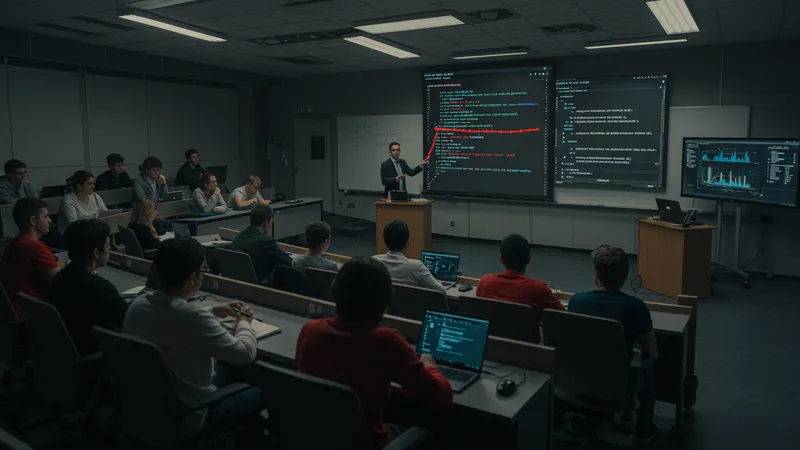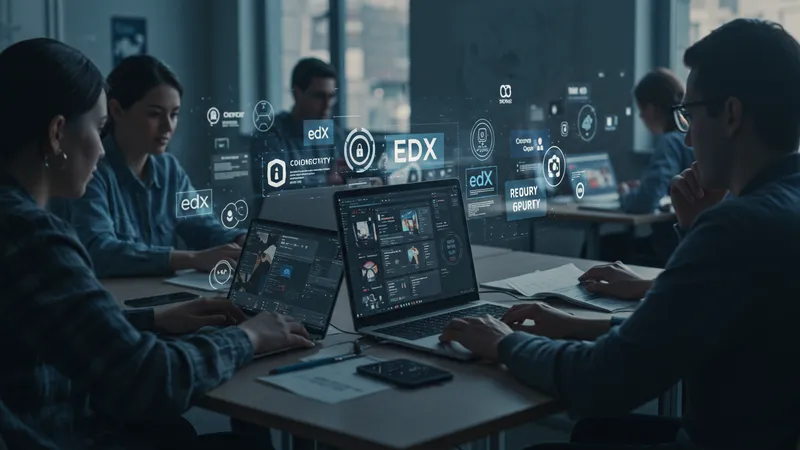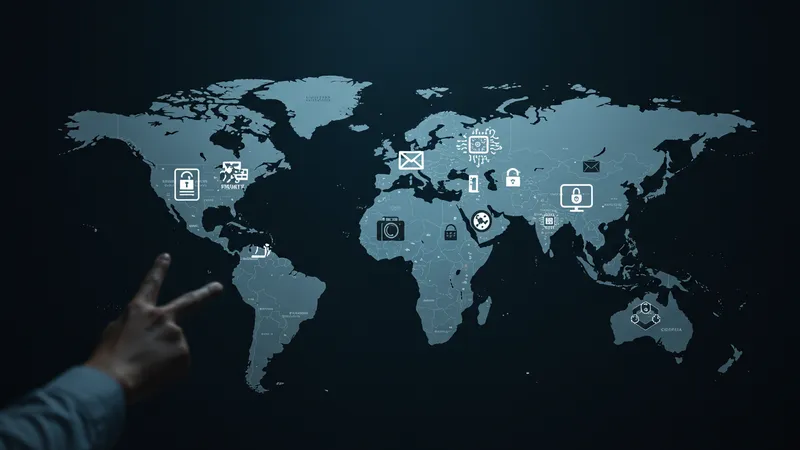

Did you know that a single typo in coding could expose an entire corporation to cyber threats? With cybersecurity breaches multiplying by the minute, experts emphasize the need for specialized education now more than ever.
With more sensitive data online, academia must align with the high-stakes battle against hackers. The urgency has never been greater—are institutions doing enough to protect your future?

Most people assume that a cybersecurity degree automatically translates to a high-paying job. Contrary to popular belief, the landscape is filled with hidden pitfalls. For example, while the top names promise lucrative job offers, it's less about the degree and more about the specific skills learned. And here comes the kicker: a recent study suggests that only 60% of cybersecurity graduates feel adequately prepared to combat real-world threats. But that’s not even the wildest part…
Academia often promises cutting-edge skills, but what's taught in classrooms may already be outdated by graduation day. Rapid evolution in cyber threats means curriculums struggle to catch up. Shocking, right? Yet, a little-discussed aspect is how hands-on experience can sometimes outweigh textbook knowledge. Don’t believe it? Just wait until you hear what industry insiders say about the real skills needed in the field. What happens next shocked even the experts…
Cybersecurity education programs often boast comprehensive curriculums, but they might not cover the critical quick-response skills employers demand. This gap leaves graduates underprepared for immediate threats. Think about it—schools are missing out on teaching the dynamic, ever-changing strategies hackers employ daily. But there’s one more twist: some colleges are beginning to partner with tech giants to bridge this gap through internships and real-world exposure.

Employers are prioritizing practical skills that aren’t typically the focus of academic programs. For instance, threat intelligence analysis and incident response are crucial skills that often get overlooked in favor of broader theory. But what if the solution lies not just in curriculum changes but in mentoring and hands-on experience? One surprising initiative is popping up: mentorship programs by industry veterans who set students on practical exercises far beyond simulations.
Some universities are now incorporating live hacking simulations that mirror real cyber-attacks. These drills provide students fewer textbook theories and more actionable strategies. One student exclaimed, “It’s like training to be a firefighter by fighting actual fires.” Are these programs enough to ground students firmly in the fast-changing world of cyber threats? The answer may lie in the passionate learners who thrive under pressure.
The industry's demand for these skills is staggering. With unprecedented demand for robust cybersecurity protocols, the burden falls on academic institutions to equip the next generation effectively. Unbeknownst to many, some schools are now incorporating ethical hacking courses, revealing more effective ways to think like a hacker rather than just thwart one. What you read next might change how you see this forever.
In a surprising turn, certifications like Certified Ethical Hacker (CEH) and Certified Information Systems Security Professional (CISSP) are sometimes valued more than degrees in the eyes of some employers. These certifications prove specific competencies and have shown to significantly boost employability. But hold your shock—many institutions are yet to adapt to this shift and continue to prioritize age-old degree pathways.

What's more, certifications often require re-certification every few years, ensuring that professionals stay updated on the latest threats and technologies. This is in stark contrast to university curricula, which might only evolve over decades. The constant renewal process through certifications helps create a more adaptable workforce ready to tackle emerging cyber threats head-on, but education systems lag drastically behind.
A wave of online platforms is stepping up to fill this educational gap, providing modular learning pathways that offer both certifications and practical, up-to-date knowledge. These next-gen platforms adapt quickly to technology changes, prioritizing real-world applications over theoretical knowledge. The catch? Many educational stalwarts refuse to acknowledge these as viable, yet they continue to lead the employment charges in tech fields.
As demand for quick adaptations grows, the pressure mounts on traditional academia to evolve and embrace these focused learning platforms. But, surprisingly, some institutions still resist the change. Could this stubborn adherence to outdated methods be threatening the employability of their graduates? What follows might just illuminate lurking opportunities we’ve overlooked.
Internships in cybersecurity provide a hands-on experience that the classroom simply cannot replicate. While the textbooks lay foundational knowledge, internships allow students to put theories into practice. Often, students cite these real-world opportunities as pivotal learning experiences. Here’s the twist: companies are rapidly increasing their internship offers, sometimes surpassing full-time job offers.

Real-time problem-solving, risk analysis, and understanding corporate security frameworks are skills honed during these internships. Students gain enrichment through exposure to practical scenarios rarely seen in lecture halls. The benefit is manifold—not only is knowledge retained better when applied, but it also offers clear insight into what a career in cybersecurity truly entails. But the importance of these internships doesn’t end here.
However, securing these sought-after positions isn't always straightforward. Companies select candidates who demonstrate adaptability and a particular zest for tackling challenges head-on. It’s a competitive gauntlet where not only skills but charisma and quick-thinking play significant roles. Are internships the best pathway to gainful employment? For many insiders, the answer is a perplexing yes, and there’s reason to believe this trend will only strengthen.
Still, internships can sometimes create disparities; not all companies offer meaningful experiences. Horror stories exist of internships where students are sidelined with menial tasks unrelated to cybersecurity. The onus is on students to research and choose wisely, yet shouldn’t academia step up to certify and curate these opportunities? Keep reading to unearth more layers in this evolving narrative.
There’s a quiet revolution underfoot in academia, with a growing chorus demanding curriculum reform in cybersecurity education. Traditionally, schools have emphasized foundational theories at the expense of real-world applicability. Reform seeks to flip the script—prioritizing dynamic content tailored to ever-evolving cyber threats. Could this finally remedy the misalignment plaguing the industry?

The urgency of this reform is highlighted by emerging partnerships between academic institutions and cybersecurity companies. Forward-thinking schools are co-designing syllabi with industry experts, ensuring graduates emerge equipped with both theoretical and hands-on prowess. But here lies the curveball—such progressive practices are still deemed as experimental by many, leaving reform patches instead of widespread changes.
The reform pushes for educators to incorporate more real-time simulations, exposing students to realistic scenarios and fostering quick, effective thinking. The question becomes, how can schools balance robust foundational teaching with the demand for cutting-edge skills? Some institutions are even considering hybrid models, extending beyond traditional classroom settings to virtual labs featuring interactive content.
While navigating through these turbulent waters, academic credibility hangs in the balance; the choice seems clear. Will educators adapt and innovate or cling to dated paradigms, risking relevancy? Stay tuned to discover deeper insights on how different regions are navigating this dynamic transformation. The next chapter could stun us with unexplored truths.
In light of traditional programs' limitations, cybersecurity bootcamps have gained traction by offering intense, condensed courses focused on real-world skills. Designed to fast-track learners into employment, these bootcamps often promise rapid mastery. The astonishing part? Many graduates of these programs have gone on to secure positions at top firms, rivaling traditional degree holders.

The appeal of these bootcamps lies in their efficiency and focus on current industry needs. Teaching methods are immersive, often resembling day-to-day challenges professionals face in the field. However, bootcamps aren’t without criticism—there’s skepticism regarding the depth of understanding and quality of education in such a short period. Nevertheless, the success stories keep people curious.
Skeptics question if these bootcamps deliver long-term career stability or if they merely provide a stepping stone. Proponents argue that the fast-paced learning and networking opportunities they offer are unparalleled. As these programs continue to proliferate, educational ecosystems face challenges, encouraging established programs to reevaluate offerings to stay competitive.
In the tug of war between traditional education and emerging bootcamps, where should aspiring cybersecurity professionals place their bets? More than just a fad, bootcamps seem poised to redefine educational norms, challenging institutions to innovate and adapt. What awaits could revolutionize your perspective on learning and career pathways.
As online learning becomes synonymous with flexibility and accessibility, platforms offering cybersecurity courses are surging in popularity. Coursera, edX, and similar platforms now host programs that were once the exclusive territory of elite universities. Having tripled in enrollment numbers, these platforms reflect a fascinating shift towards democratized education.

The all-encompassing nature of these courses offers both foundational knowledge and sector-specific skills, frequently employing state-of-the-art technologies. Students are lured by cost-effectiveness, as many courses come with lower price tags compared to traditional degrees. This shift towards democratized learning prompts an inevitable debate: does affordability compromise quality?
Yet, the results speak for themselves. Testimonials and case studies repeatedly highlight the high satisfaction rates of participants who found careers post-completion. The flexibility to learn at one's own pace has also empowered a range of people—from mid-career changers to young professionals—positively diversifying the talent pool in cybersecurity.
As this trend evolves, institutions find themselves at a crossroads. Should they embrace hybrid education models to complement online learning, or risk becoming obsolete? What’s clear is that the digital education evolution is just beginning, setting the stage for innovative developments. The next transformation awaits just a scroll away!
The field of cybersecurity doesn't exist in a vacuum, isolated from worldwide cultural and educational influences. Different regions show varying priorities, legal frameworks, and industry demands in cybersecurity education. An example is the focus on data privacy principles in Europe versus a more business-centric industry model in the United States. The disparity has resulted in a global talent inconsistencies that's often overlooked.

Europe, with its stringent data protection policies, emphasizes privacy by design, making its cybersecurity curriculums particularly robust in legal knowledge. Meanwhile, in Asia, where tech innovation thrives, educational institutions prioritize rapid technological adaptability. These regional distinctions catalyze varied skill sets among graduates, creating unique pros and cons in global employability.
Despite these distinctions, there exists a stark commonality—a universal call for more seamless industry-academia collaboration. The need to unify education approaches with industry demands resonates worldwide, though execution still lags. As global communication networks tighten, sharing resources and aligning educational objectives becomes crucial.
This calls for broader dialogues on international certification standards in cybersecurity education. Would a standardized approach ease cross-border employability or homogenize diverse, culturally-rich learning systems? What follows can help decode how local education innovations are transforming the world's security landscape.
In a bold educational stride, ethical hacking courses teach students how to get into the mindset of cybercriminals. Far from fostering malintent, such programs actually create an advantage. By understanding adversarial tactics, professionals can more robustly defend systems, mirroring the thought strategy of any great chess player.

Ethical hacking courses combine theoretical lessons with practical, immersive experiences. Simulations replicate high-stake cyber-attacks, enriching students’ ability to anticipate and counteract offensive moves. As law enforcement increasingly wields these skills against adversaries, the necessity for such courses in academic curriculums multiplies.
Critics argue that ethical hacking should be limited to niche educational settings due to its potential misuse. Nevertheless, the overwhelming industry demand for 'white-hat' hackers begins to dispel misgivings, with strong ethical guidelines transforming ambiguity into advantage. Companies now routinely employ white-hat hackers to test their systems, reinforcing defense layers before breaches occur.
Given these positive outcomes, ethical hacking education offers new horizons in cybersecurity, expanding as a highly respected branch within the field. The journey to mastering the hacker mindset reshapes students’ understanding of security measures, posing the ultimate question: could this innovative approach redefine industry standards? The answer's likely more revolutionary than anticipated.
While cybersecurity is generally seen as a lucrative field, new job market research highlights crucial nuances that alter the rosy stereotype. Not every position offers the six-figure salary many imagine, leading to a stark examination of what employment in cybersecurity truly entails. Behind the enticing headlines lies a complex web of expectations and realities.

Diving deeper, there exist plentiful opportunities for internships and entry-level roles, but they sometimes offer lower starting salaries than expected. Students burdened by education costs find themselves in a bind, wondering if their academic investments yield adequate returns. This variance often discourages aspirants unprepared for the industry's early financial realism.
However, many professionals experience sudden salary hikes with just a few years of experience or new certifications, bringing rapid employability progression. Success stories of individuals ascending within organizations in unprecedented timeframes contrast initial financial disappointments, promising a balanced perspective on the employment landscape.
These employment dynamics emphasize that while embellishments attract, prospective cybersecurity experts should prepare for a nuanced journey. Career navigation requires more than academic prowess; resilience and adaptability shape careers just as readily. Discover the ultimate truth about navigating this challenging field as we delve deeper into its evolving narrative.
Cybersecurity remains a male-dominated field despite gradual progress towards gender parity. Women constitute a mere 20% of the industry's workforce even today. Striving to dismantle stereotypes and historical biases, various initiatives aim to encourage diverse participation and usher in broader gender inclusivity.

Increased scholarship availability for women in cybersecurity aspirations has inspired a generation more representative of societal demographics. Industry leaders now champion women-centric networking events and workshops, fostering greater representation. Nonetheless, dispelling misconceptions that technology is a 'men’s world' continues as a steadfast struggle.
Encouragingly, women bring fresh perspectives to cybersecurity protocols while balancing traditional roles and expectations, injecting dynamic vigor essential to innovation. Despite these contributions, retention remains a daunting challenge as women frequently leave tech due to exclusionary cultures. Why does this trend persist, and what are organizations doing to tackle it?
Addressing gender disparities not only encourages inclusivity but enriches the cybersecurity landscape with diverse voices essential to combating complex threats. While progress demands sweeping changes, the movement acquires momentum, indicating transformative solutions in the making. Unravel fresh insights on this pivotal topic and gain instrumental strategies to foster more inclusive tech environments.
Advancements in educational technology pave the way for transformative learning paradigms in cybersecurity. Virtual reality labs, AI-driven personalized learning plans, and blockchain credentials present tantalizing glimpses into future offerings. The goal? Deliver real-world skills with exhilarating efficacy, leaving no talent unutilized.
Imagine donning VR headsets and stepping into a simulated digital world fraught with live threats—a unique approach allowing students to experience real-time crisis navigation. AI-backed algorithms now customize course material to individual needs for the utmost learning results. The future isn't distant; it's arriving faster than anyone anticipated.
Some institutions explore incorporating blockchain technology to secure and verify educational accomplishments, marking a significant leap toward data security in educational environments. These setups promise verifiable CVs, transforming recruitment landscapes with precision and transparency. As new methodologies emerge, traditional education scrambles to integrate competency-focused learning into prehistoric models.
This dazzling glimpse into tomorrow's educational innovations underscores the imperative for readiness and foresight within academia and industry alike. Is this future simply a fad, or the hard reality we must embrace to safeguard generations? The comprehensive shifts on the horizon invite dialogue and ingenuity, offering liberty and endless potential.
In summary, the seismic shifts within cybersecurity education reflect a world catching up with rapid technological advancements. The innovations, the reforms, and the challenges paint a vibrant picture of a future where learning adapts to serve the burgeoning needs of an interconnected society. Embrace the unknown, as this ever-evolving field will define careers, security, and global partnerships for decades, inviting you to become part of the solution. Now’s the time to share these game-changing insights and ignite wider conversations throughout your network. Bookmark this page, discuss it with your peers, and take action to shape the cybersecurity educational continuum for future generations. Let curiosity be your guide!